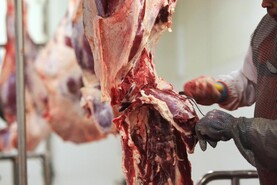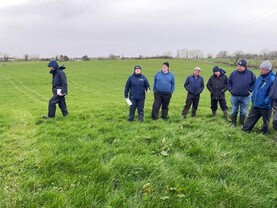The 2017 Teagasc eProfit monitor analysis for Newford Farm, the 100-cow suckler-to-beef herd in Athenry, Co Galway, captures a difficult year for the farm. The farm generated a gross margin of €674/ha, which unfortunately fell significantly below the target gross margin for 2017 of about €1,000/ha.
Fixed costs for the farm totalled €723/ha, leaving the farm making a net loss of -€49/ha or a total loss of -€3,145. This is an improvement on 2016 when the farm made a net loss of €24,059 (-€431/ha), as detailed in Table 2, but this is not something to write home about.
The net margin figure includes casual labour utilised around calving and at weekends but does not include the farm manager’s wage or any land rental costs. It also includes interest on borrowings. There is no Basic Payment Scheme or Areas of Natural Constraint payment, with the only premia received being the Beef Data and Genomics Programme payment of €8,099. If included, it brings the farm’s finances marginally into the green with a net margin including direct payments of €4,954 or €77/ha.
Farm performance
Before delving deeper into the physical and financial performance, it is worth noting that the farm has consistently excelled in terms of calving and breeding performance and grassland management. The herd calved 107 cows in 2017 with calving front-loaded to the first seven weeks in a calving spread that commenced on 2 February and finished on 22 April. There were two losses from scanning to calving and one mortality post-calving.
Four cows had twins leaving the herd with a calves per cow figure of 1.04 per cow calved and 0.96 calves per cow submitted for breeding. The calving interval from 2016 to 2017 was 349 days. There was one case of calf mortality in the second half of 2017, with one calf lost due to pneumonia, leaving the year-end figure for 2017 at 107 weanlings.
Breeding performance was also another strong point for the herd. Ninety-three out of the 99 cows put forward for breeding were scanned in-calf. Within this, 64 cows held to first service, 18 held to second service, while stock bulls were released from week seven to 10 of breeding and successfully served 11 cows.
The herd’s breeding performance was the catalyst for the farm’s decision to sell the two stock bulls and move to 100% AI in 2018.
Grassland output was good with the farm growing in excess of 14t DM/ha on average but utilisation was much trickier because the farm contended with 2ft of rainfall from the first week of June to the first week of November. This greatly curtailed performance of finishing cattle and led to earlier housing dates for all stock and subsequent higher costs which will be discussed in more detail below.
Financial performance
The farm produced a gross output in 2017 of 65,024kg or 1,016kg/ha and 380kg/LU. The sales value totalled €171,893, which comprises of €28,950 sales in early 2017 (carryover of 2015-born progeny) while sales for summer and autumn 2017 are detailed in-depth in tables 3 and 4.
Purchases, which covers the cost of bringing replacement heifers from contract-rearing, totalled €29,458, and with inventory changes the farm had a gross output value of €128,336. This gives the farm a gross output value/ha of €2,005, which on the face of it is relatively good for a suckler-to-beef system.
The system comes under pressure when variable and fixed costs, which are detailed in Table 1, are deducted. The farm budgeted to reduce its variable costs from €1,539/ha in 2016 to €1,040/ha in 2017. Variable costs/ha reduced to €1,332 but this was more from a dilution of a higher area farmed with total variable costs unchanged at €85,229. Looking at where costs exceeded targets, there are a number of elements that stand out, with the greatest of these being concentrate costs.
The farm budgeted for a spend of €12,840 or €212/ha on concentrates and ended up with a spend of €352/ha. The higher concentrate bill can be directly attributed to weather greatly disrupting finishing of 2016-born progeny.
The programme in 2017 targeted finishing all 42 heifers off grass and the 20 strongest steers from a batch of 47. Heavy rainfall through June and July reduced grass utilisation and a decision was taken to introduce meal to these 20 steers and heifers on 9 August at 5kg per head, with a target to finish off grass in the following six- to eight-week period.
Weather continued to deteriorate in August and September, forcing a readjustment of the finishing programme. The 27 lighter steers and nine of the lightest heifers were housed on 13 September to prioritise grass and stay on track with finishing 33 heifers and 20 steers off grass. The 33 heifers were finished off grass which was a good feat considering the weather but the 20 steers were doing excessive damage and had to be housed on 13 October.
They joined steers already housed on silage and 6kg concentrates. This was gradually built up to 8kg and in late November a decision was made to transfer these to ad-lib feeding to conserve silage supplies which were also coming under pressure. In total, steers ended up receiving a meal allocation in the region of 900kg to finish.
Despite the extra concentrates fed, carcase weights were disappointing, with heifers averaging 291kg and steers 341kg. The blueprint for the system is heifers achieving a carcase weight of 330kg finished off grass and steers achieving a carcase weight closer to 360kg to 370kg, with 50% finished off grass.
The earlier housing of finishing animals and housing of cows a month earlier than planned in mid-September ate into silage reserves to the tune of over 200t and resulted in the purchased forage cost increasing from the budgeted figure of €1,400 (forage purchased early 2017) to €4,466 or €70/ha.
The farm has 200t of silage in the pit after winter, which should stand to it for the coming year.
Looking at the other costs, contractor charges also significantly exceeded the target of €10,555 and came in at €16,963. Part of the higher costs can be attributed to more surplus bales being made and higher slurry spreading charges from earlier housing.
Veterinary came in on target, as did straw, which halved in cost from 2016. This was a good feat given that the cost of bales increased from €16 in 2016 to €22-€30 in 2017, while fertiliser costs increased slightly with higher volumes applied in the second half of 2017 to try and keep grass growth on track.
The net result of the higher variable costs, as already touched on, is total costs coming in at €300/ha or €22,115 higher than budgeted. Fixed costs were not expected to differ greatly which can be expected with much of the costs already committed to the system.
Where to from here
The initial blueprint carried out for the system is for the 100-cow suckler-to-beef farm, utilising first cross Angus and Hereford genetics from the dairy herd as its cow type, to deliver a net margin of €520/ha by 2019 or a total net profit of €29,000.
This is based on variable costs coming in at around 45% to 50% of gross output. Failing to achieve the higher target carcase weights off grass, or an even higher carcase weight to cover additional costs if extra animals are finished indoors will make this a hard feat to achieve. Genetics of the herd are improving. Replacements are also being selected with a greater focus on carcase weight and conformation, while the 2017-born yearlings appear to be a more uniform bunch of cattle with a higher degree of Charolais genetics.
Performance of progeny in year one is excellent, with weanlings continually achieving an average daily gain from birth to weaning in excess of 1.2kg to 1.3kg per day. It is performance in year two when dairy genetics appear to pose a greater influence that will be the challenge to overcome if target carcase weights are to be achieved.
People visiting the farm have raised the suggestion that an under-16-month bull-beef finishing system might be the catalyst for increasing carcase weights while taking pressure off the farm to meet a massive demand for grass during the autumn. There is no doubt that this would help the system but the blueprint being tested is to see if the system can deliver in a steer and heifer finishing system.
There is also the significant fact of weather having a massive influence with the 2018 year already off to a slower start with turnout of yearlings delayed by six to eight weeks. All of these factors will be scrutinised by management and stakeholder teams in trying to get the farm back on track.
The Newford project is currently in year four of its seven-year timeline. Regarding the project costs, Dawn Meats employs the farm manager and covers all costs of employment. Dawn Meats also covered capital costs to establish the farm (livestock and capital investment), while Teagasc covers land rental costs.
The management team is made up of the farm manager and members from Teagasc, Dawn Meats and the Irish Farmers Journal, while the stakeholder team also has farmer representation.






 This is a subscriber-only article
This is a subscriber-only article










SHARING OPTIONS: